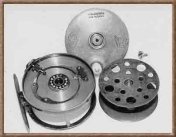
Fly fishing reels. How they’ve changed.
"For everything you have missed, you have gained something else, and for everything you gain, you lose something else."
- Ralph Waldo EmersonTo catch beauties such as this, you need good fly fishing reels. So important to the angler. Just how far along have they come!
Ever since the native American first tied a length of sinew to a pole and dipped it into the water to try catching fish, man has tried to improve the manner of fishing.
The art of making fly fishing reels has gone on for at least 300 years. Basically the idea is to wind the line around a spool, let it out during the casting, have the line readily available for when a fish hits, and have the ability to tire the fish with a brake or drag. That’s is. Sounds simple doesn’t it.
The early reels were made of steel and had to be kept greased at all times to avoid rusting. Then came brass reels, but they had to have some steel parts because brass was softer and wore down quickly.

Some of the reels had jewel bearings, such as you would find in a fine watch. These bearings were made of synthetic corundum and were very hard thus resisting wear. A little oil every once in awhile and they worked just fine.
The workmanship was superb on the Meek fly fishing reels. The parts were made by hand. The german silver screws were individually numbered. The horn finger grip located at the 12:00 position counter balanced the “S” shaped handle. There are only two of these #% Meek reels known to exist. This one and one presented to president Grover Cleveland.
After a few years, the Meek company merged with the Milam company to form Meek and Milam and in the 1870s began to produce some of the finest Kentucky reels ever made.
 Back in 1872, William Hardy was establishing himself as a gunsmith in his home town of Alnwick, Northumberland in England. In those years, people were trained and served as apprentices to master craftsmen for years until they too attained the skills necessary to produce superior goods. William joined up with his brother John and the Hardy Brothers Partnership was begun. Their high quality shotguns and pistols were in great demand but they both had a passion for fishing.
Back in 1872, William Hardy was establishing himself as a gunsmith in his home town of Alnwick, Northumberland in England. In those years, people were trained and served as apprentices to master craftsmen for years until they too attained the skills necessary to produce superior goods. William joined up with his brother John and the Hardy Brothers Partnership was begun. Their high quality shotguns and pistols were in great demand but they both had a passion for fishing.
This was the basis for the Hardy rods and reels history. For the first 20 years the company made world famous rods. In 1891 some of the first hardy “Perfect” fly fishing reels was produced.
 The Perfect had one serious fault. It was the drag mechanism that really was hardly effective. It wasn’t serious enough to keep the Hardy reel from being the number one reel maker for the best part of a century, but it proved to be the one problem that plagued the company over the years.
The Perfect had one serious fault. It was the drag mechanism that really was hardly effective. It wasn’t serious enough to keep the Hardy reel from being the number one reel maker for the best part of a century, but it proved to be the one problem that plagued the company over the years.
The photo here of a 3” 1896, all brass “Perfect” model. It has the straight line and oval markings, rod in hand trade mark. It shows the ivorine handle, oil hole in the center of the face, strap over tension adjuster and the open ball race.
 The Angel performance fly reels represent the top of the class of fly fishing design perspective. These reels set the standard to which every manufacturer must now aspire. Competitively priced, the line has five distinctive models from which to choose. Soon it will become one of the best-selling Hardy reels of all time. The reel is made from the highest quality aluminum, specially manufactured to ensure both lightness and extreme strength. It is then subjected to an accelerated testing and maturing process that gives the highest possible performance and durability.
The Angel performance fly reels represent the top of the class of fly fishing design perspective. These reels set the standard to which every manufacturer must now aspire. Competitively priced, the line has five distinctive models from which to choose. Soon it will become one of the best-selling Hardy reels of all time. The reel is made from the highest quality aluminum, specially manufactured to ensure both lightness and extreme strength. It is then subjected to an accelerated testing and maturing process that gives the highest possible performance and durability.
The reel is anodized to architectural standards thus increasing the hardness of the aluminum by an amazing four hundred per cent. The satin-silver finish is deliberately made anti-glare and is complemented by champagne-gold highlights, therefore proclaiming the reel for what it is – a timeless masterpiece

Return from Fly Fishing Reels to Whistler Outdoors



